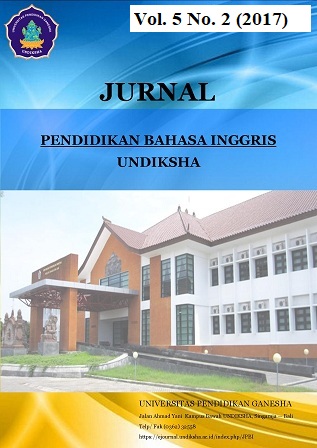THE EFFECT OF TEACHING USING AUDIOVISUAL (VIDEO) MEDIA, ON SEVENTH GRADE STUDENTS’ LISTENING COMPREHENSION AT SMP NEGERI 1 MENGWI ACADEMIC YEAR 2017/2018
DOI:
https://doi.org/10.23887/jpbi.v5i2.14869Abstract
Penelitian ini bertujuan untuk mengetahui perbedaan antara siswa kelas tujuh yang diajar dengan media audiovisual (video) dengan siswa yang diajar tanpa media audiovisual atau dengan media audio saja (cara konvensional dalam mengajar listening) di SMP Negeri 1 Mengwi, tahun ajaran 2017/2018. Populasi penelitian ini adalah seluruh siswa kelas tujuh di SMP Negeri 1 Mengwi, tahun ajaran 2017/2018 yang dimana jumlah seluruhnya adalah 402 siswa. Sampel penelitian ini adalah kelas VII A dan VII B di SMP Negeri 1 Mengwi yang dimana tiap kelas terdapat 32 jumlah siswa. Data dikumpulkan dengan menggunakan tes pilihan ganda (multiple choice test), dengan total jumlah pertanyaan adalah sebanyak 20. Data yang dikumpulkan dianalisis menggunakan analisis statistik deskriptif dan statistik inferensial (uji-t). Berdasarkan hasil analisis, data menunjukkan bahwa thit > ttab yaitu 7.34 > 1.99. Jika dibandingkan akan terlihat bahwa thit > ttab. Sehingga dapat disimpulkan bahwa terdapat pengaruh yang signifikan dari mengajar listening dengan menggunakan media audiovisual (video) daripada menggunakan cara yang konvensional dalam mengajar listening (dengan menggunakan media audio saja).Kata Kunci : Pemahaman Listening, Media Audiovisual, Media Audio (Cara yang biasa)
The purpose of this study was to know the differences between the seventh-grade students who were taught by audiovisual (video) media and the students who were taught without audiovisual media or by audio media only (conventional way in teaching listening) at SMP Negeri 1 Mengwi, academic year 2017/2018. The population of this study was the whole students in class VII of SMP Negeri 1 Mengwi academic year 2017/2018 in which the total students were 402. The samples in this study were Class VII A and VII B in SMP Negeri 1 Mengwi in which each class consisted of 32 students. The data were collected by using a multiple-choice test, with the total number of the questions were 20 questions. The data collected were analyzed by using descriptive statistics analysis and inferential statistics analysis (t-test). Based on the result of the analysis, it showed t.obs > t.cv which was 7.34 > 1.99. If compared, it showed that t.obs > t.cv. Therefore, it can be concluded that there was a significant effect of teaching listening by using audiovisual media rather than using the conventional way in teaching listening (by using audio media only).
keyword : Listening Comprehension, Audiovisual Media, Audio Media (Conventional Way)
Published
2018-07-24
Issue
Section
Articles
License
Authors who publish with the Jurnal Pendidikan Bahasa Inggris Undiksha agree to the following terms:- Authors retain copyright and grant the journal the right of first publication with the work simultaneously licensed under a Creative Commons Attribution License (CC BY-SA 4.0) that allows others to share the work with an acknowledgment of the work's authorship and initial publication in this journal
- Authors are able to enter into separate, additional contractual arrangements for the non-exclusive distribution of the journal's published version of the work (e.g., post it to an institutional repository or publish it in a book), with an acknowledgment of its initial publication in this journal.
- Authors are permitted and encouraged to post their work online (e.g., in institutional repositories or on their website) prior to and during the submission process, as it can lead to productive exchanges, as well as earlier and greater citation of published work. (See The Effect of Open Access)













